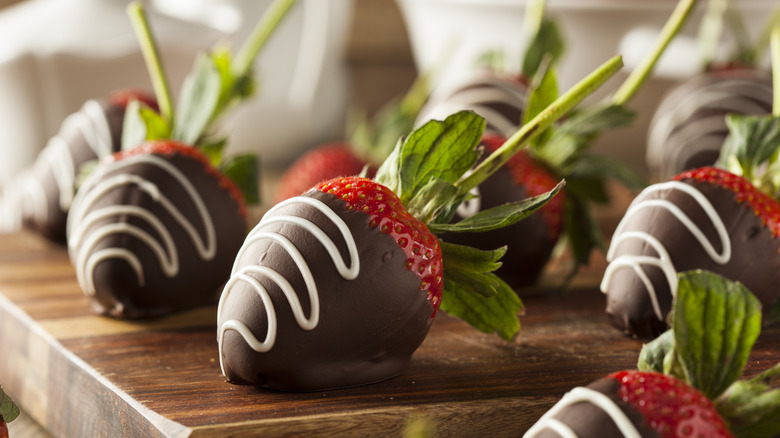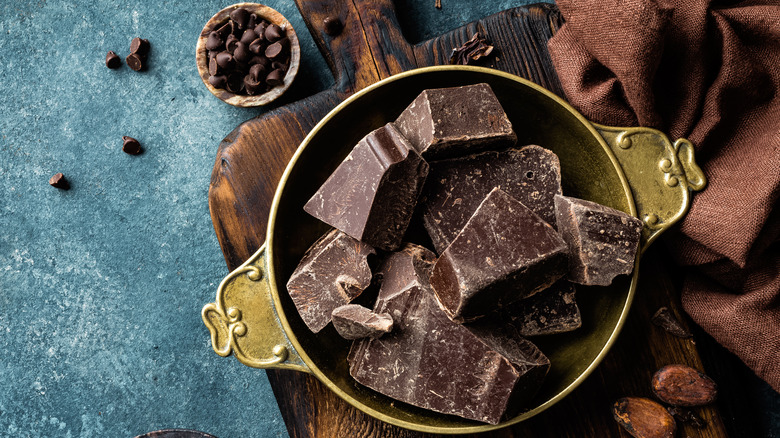The Best Type Of Chocolate For Dipping Strawberries
Popular as a Valentine's Day treat to share with loved ones (or to celebrate self-love), chocolate-covered strawberries are a delectable dessert enjoyed any time of year — including amidst the summer heat, when the fruit is seasonal and fresh. To make them, ripe strawberries are dipped in melted chocolate, which is allowed to cool and harden, forming a crisp outer shell that melts in your mouth with each bite of juicy fruit.
Due to this simple, yet satisfyingly refreshing recipe, when making handmade chocolate-covered strawberries, it's key to choose a dipping chocolate that's not overly sweet. Specifically, a semi-sweet or bittersweet baking chocolate is best for the task. Since baking chocolates are intended to be used in culinary methods where the baker will customize and add their own sweeteners and flavors to the mix, they typically contain higher levels of cacao — and less sugar, other emulsifiers, and flavorings — compared to your standard bag of Nestlé chocolate chips.
The higher cacao content of baking chocolates is perfect for letting the rich flavors of chocolate shine to balance the floral sweetness of the strawberries. Depending on the baking bar (and the origin of the cacao beans), this means its subtle flavor notes — including roasted cherry and even hints of woodsy bark — are more accentuated, to complement the fruit and truly elevate the dipped treat.
Choosing the right baking chocolate for strawberries
When selecting baking chocolate for strawberries, it's essential to consider cacao content. First, there is baking chocolate that's unsweetened. While this type is great for melting and folding into brownie batter, unsweetened varieties are 100% cacao and will be extremely bitter (similar to the taste of raw cocoa powder). Unless you're especially fond of ultra-bitter taste, you'll want to avoid unsweetened chocolate for covering strawberries.
Instead, go for a semi-sweet or bittersweet baking variety. These baking chocolates vary in their level of cacao, but will typically have a more pronounced chocolate flavor (since they contain at least 35% cacao) and less sweetness, without the astringency of unsweetened chocolate. If you'd like an especially dark chocolate with no added sugar or milk solids, go for dark baking chocolate with 60% cacao or above (some go up to 72% or 80% cacao). For a chocolate with slightly higher creamy notes, choose a baking chocolate that contains some milk solids (though this is different and has less dairy notes than milk chocolate).
Baking chocolate comes in a variety of forms, including chips, chunks, and bars. Compared to average bagged chocolate chips, which are made to hold their shape in cookie dough as it bakes in the oven, baking chocolate typically contains less emulsifiers and melts more readily. Chunks and chips are smaller and will melt quickly, while you'll need to chop or grate bars or squares prior to melting.
Tips for dipping strawberries in your favorite chocolate
When you've got your baking chocolate and strawberries — rinsed and dried — on hand, first break out the double-boiler (or stack a heatproof bowl over a small saucepan with simmering water). Gently melt your baking chocolate in the bowl, stirring frequently until smooth. All chunks or chips should be completely dissolved and incorporated at this point, and the texture should be pourable.
Then, dip each strawberry individually, holding them by the upper portion with the stem (or skewer them for a cleaner process), and twirl the fruit in the bath of chocolate to fully coat. Place dipped strawberries on a parchment-lined pan or plate, or nestle them in paper baking cups, and allow them to sit so the outer chocolate coating becomes hardened and crisp.
If desired, before your chocolate sets, you can add nonpareils or cookie crumbles for an extra striking appearance and textural depth. Once you try quality baking chocolate, you'll soon see that it's far more quintessentially chocolaty than other chocolate varieties that don't melt as well or form that crisp outer shell. And maybe soon, you'll want to experiment with dipping other ripe fruits, as well as using other cocoa-forward varieties, like pink ruby chocolate. With the right ingredients, the possibilities are endless.


